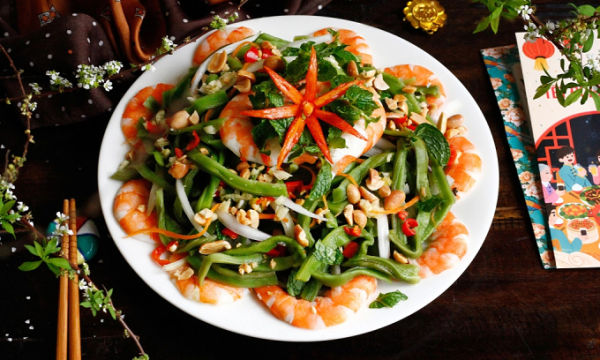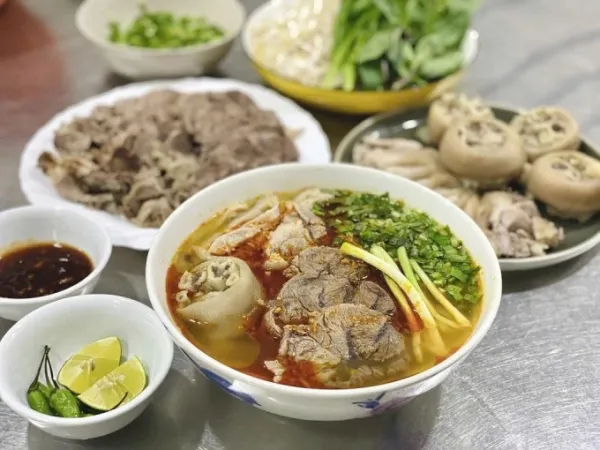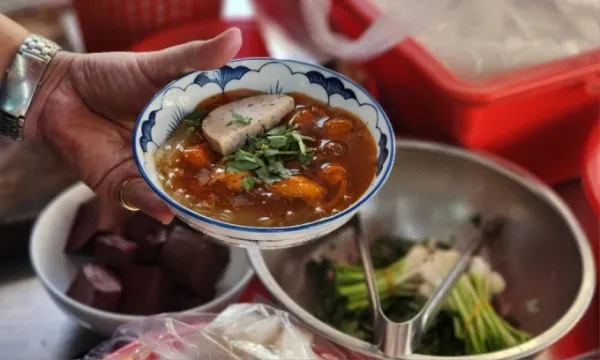
From Hanoi to Hue, they point to five dishes that epitomize Vietnam: broken rice, jelly vegetable salad, Hanoi’s tofu-and-shrimp-paste noodles, Hue’s spicy beef noodle soup, and Nam Pho thick noodle soup.
Broken rice
Chef Duy Nguyen of Little Bear restaurant in Ho Chi Minh City – Michelin Selected in 2024 and 2025, and winner of the 2024 Michelin Young Chef Award – points to with tamor broken rice.
|
A plate of with tam that features grilled pork, egg meatloaf, shredded pork skin, and pickles. Photo by Cao Ky Nhan |
How started as a humble meal, made from the fractured rice grains once considered scraps. It usually comes with toppings such as grilled pork chops and shredded pork skin, all tied together with sweet and sour fish sauce.
The dish is found everywhere from upscale restaurants to street stalls.
Thailand-based Michelin chef Andrew Martin said if there’s a place in Ho Chi Minh City where all walks of life can gather, it is around a streetside with tam stall.
Mountain jelly vegetable (king vegetables) salad
For Vo Thi Bich Thuan, owner of Vi Que Kitchen in Hue, a Michelin Bib Gourmand restaurant in 2025, the standout choice is mountain jelly vegetable salad.
|
Shrimp, herbs, peanuts, and mountain jelly vegetable top a plate of king money salad. Photo by Bui Thuy |
Originating in Hue, Vietnam’s former imperial capital, the salad’s name reflects its regal roots: King’s money means “offered to the king.”
In the past this crunchy vegetable was considered special enough to be served at the imperial court in Hue.
“This jelly-like plant was once reserved for emperors, prized for its cooling, detoxing and skin-loving qualities,” Thuan elaborates.
Rice vermicelli with fried tofu and shrimp paste (good bye mom tom)
Le Minh Tung, owner of Xoi Com restaurant in Hanoi, Michelin Selected every year since 2023, recommends good bye mom tom.
|
A tray of good bye mom tom is usually served with extras like cha com (green rice pork sausage) and doi (pork blood sausage). Photo by Bui Thuy |
The dish combines rice vermicelli, fried tofu and fermented shrimp paste. When served, the shrimp paste is usually mixed with lime, chili and sugar to become sour, spicy, salty, and sweet all at once.
The dish is best experienced at casual street stalls, where tofu is fried in tiny kitchens. Hanoians often eat it at lunchtime.
Spicy beef noodle soup – bun bo Hue
Tu Dang, owner of Nha Tu restaurant in Hue and a 2025 Bib Gourmand awardee, is a fan of the spicy beef noodle soup, bun bo Hue.
 |
|
A bowl of bun bo Hue is topped with beef and pork hock in a spicy broth. Photo by Thai Nguyen |
He says bun bo Hue embodies the flavors of central Vietnam, being rich with beef, pork knuckle, herbs, fermented shrimp paste, and the defining aroma of the region, lemongrass.
Nam Pho thick noodle soup
Chef Vo Thanh Vuong of Coco Dining in Hue, which got a Michelin star in 2025, champions Nam Pho thick noodle soup.
 |
|
Nam Pho thick noodle soup. Photo by VnExpress/Bich Phuong |
“Though lesser known internationally, it is unforgettable once tasted,” he gushes.
The soup has noodles in a thick, savory broth made from pork, crab or shrimp and colored red-orange with annatto oil.
A specialty of Hue, it is considered both street food and a culinary treasure.